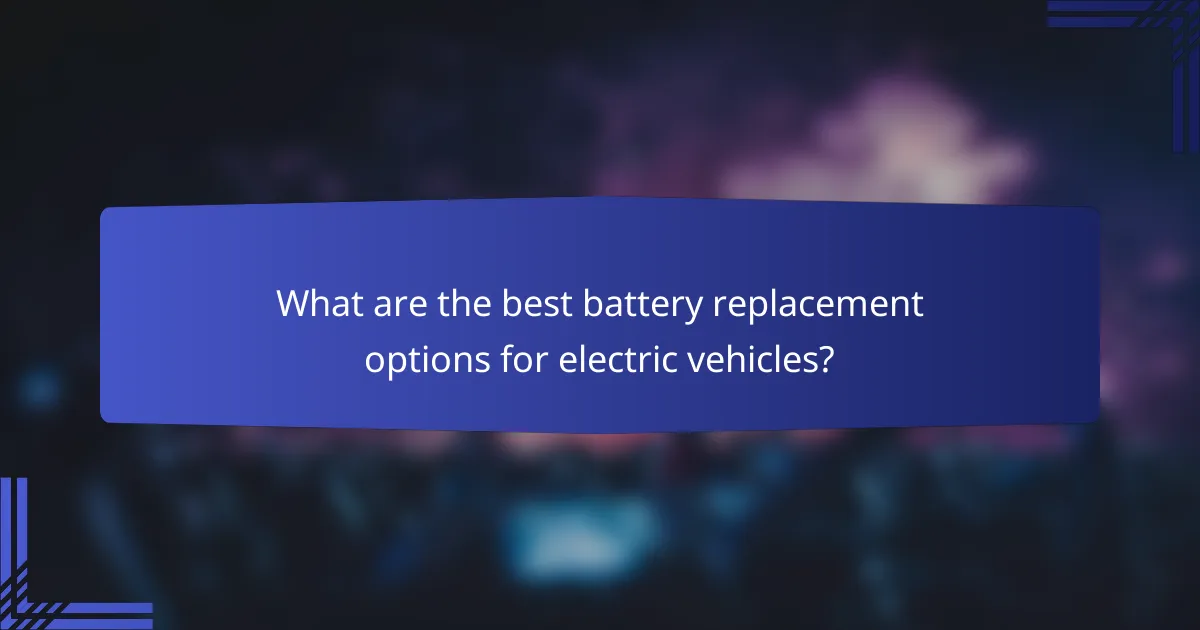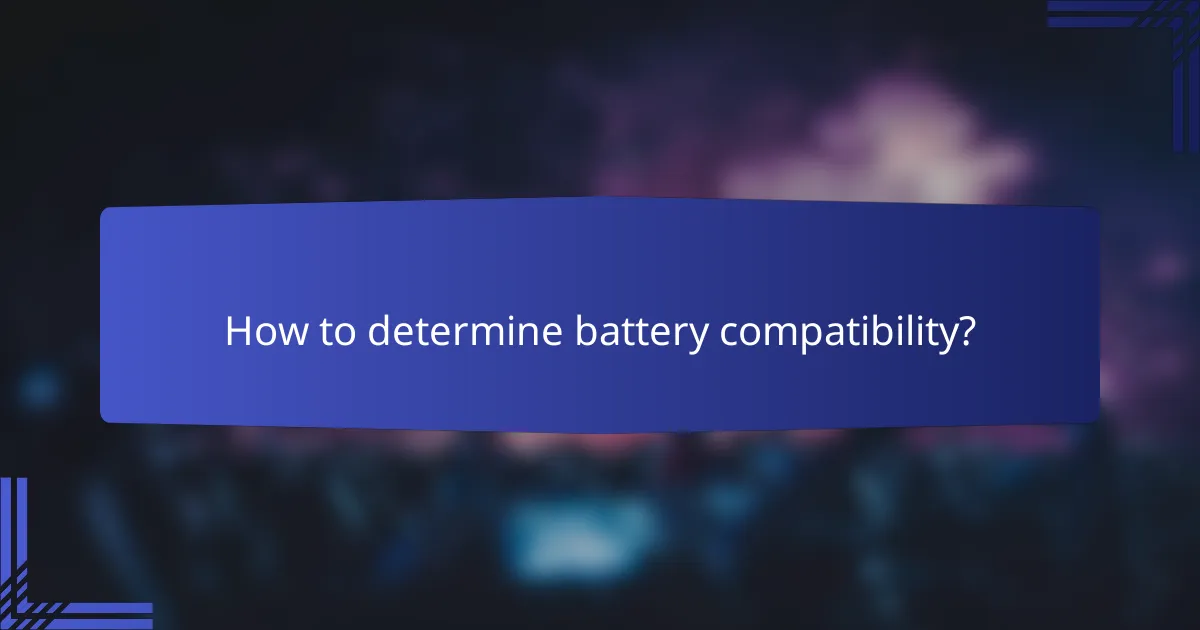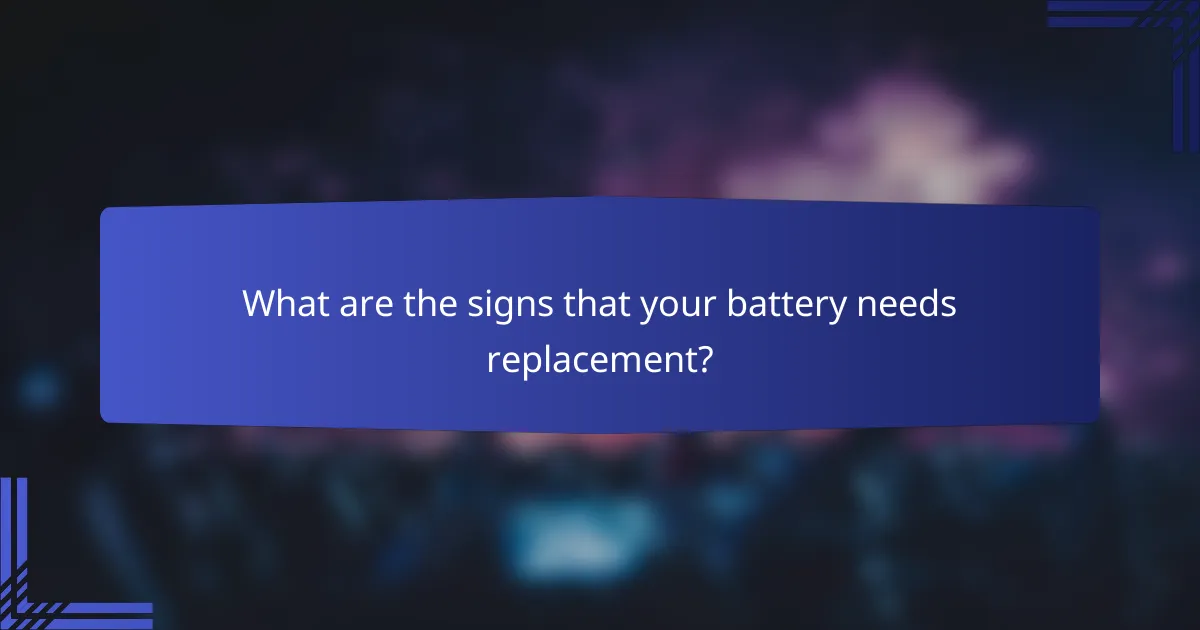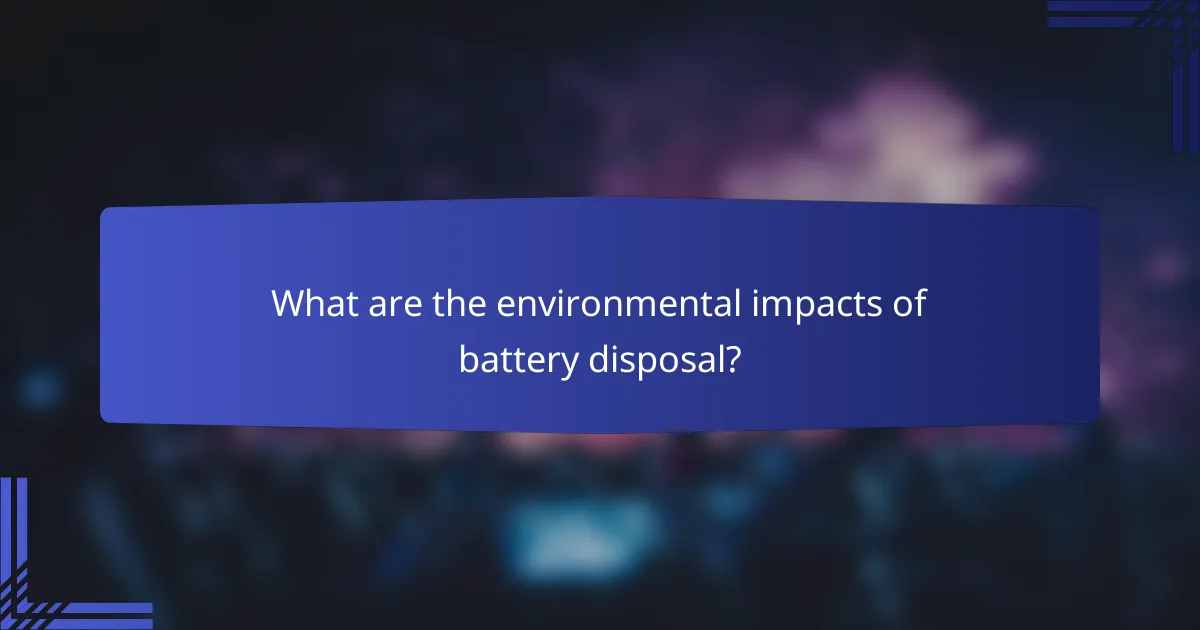When it comes to battery replacement for electric vehicles (EVs), there are several options to consider, including OEM battery packs, aftermarket solutions, and refurbished batteries. Each choice presents unique advantages in terms of cost savings, longevity, and compatibility with your vehicle. By understanding these factors, you can make an informed decision that best suits your needs and budget.

What are the best battery replacement options for electric vehicles?
The best battery replacement options for electric vehicles (EVs) include OEM battery packs, aftermarket battery solutions, and refurbished batteries. Each option has its own advantages and considerations regarding cost, longevity, and compatibility with your vehicle.
OEM battery packs
OEM (Original Equipment Manufacturer) battery packs are produced by the vehicle manufacturer and are designed specifically for your EV model. They typically offer the best compatibility and performance, ensuring that all systems work seamlessly together.
However, OEM batteries can be significantly more expensive, often ranging from several thousand to over ten thousand USD, depending on the vehicle. They also come with warranties that can provide peace of mind regarding longevity and reliability.
Aftermarket battery solutions
Aftermarket battery solutions are produced by third-party manufacturers and can be a more affordable option for EV owners. These batteries may offer similar performance to OEM packs but at a lower price point, often ranging from 20% to 50% less than OEM options.
While aftermarket batteries can provide good value, it is crucial to ensure they are compatible with your specific EV model. Researching the manufacturer’s reputation and warranty terms can help mitigate risks associated with quality and longevity.
Refurbished batteries
Refurbished batteries are used batteries that have been repaired and tested for functionality. This option can be the most cost-effective, with prices typically ranging from a few hundred to a couple of thousand USD, depending on the battery’s condition and capacity.
While refurbished batteries can save money, they may come with limited warranties and shorter lifespans compared to new options. It’s essential to verify the refurbishment process and seek batteries from reputable sources to ensure reliability and performance.

How much can you save by choosing aftermarket batteries?
Choosing aftermarket batteries can lead to significant savings compared to original equipment manufacturer (OEM) options. Typically, aftermarket batteries cost less, offering a budget-friendly alternative without compromising quality.
Cost comparison with OEM batteries
Aftermarket batteries generally range from 20% to 50% less expensive than OEM batteries. For example, if an OEM battery costs around $200, an aftermarket option might be available for $100 to $160. This price difference can be particularly appealing for consumers looking to minimize expenses.
However, it’s essential to consider the warranty and return policy when comparing costs. OEM batteries often come with longer warranties, which can be a factor in long-term value. Always check the specifications and reviews of aftermarket options to ensure they meet your needs.
Long-term savings analysis
While the initial cost of aftermarket batteries is lower, their longevity can vary. Many aftermarket batteries perform adequately but may not last as long as OEM batteries, which can affect overall savings. If an aftermarket battery lasts for two years instead of three, the savings might diminish over time.
To maximize savings, consider the usage patterns of your device. If you frequently use high-drain devices, investing in a higher-quality aftermarket battery may provide better longevity. Additionally, keep an eye on maintenance practices, as proper care can extend the life of any battery, further enhancing your savings.

What factors affect battery longevity?
Battery longevity is influenced by various factors including temperature, charging habits, and the type of battery used. Understanding these elements can help users maximize the lifespan of their batteries and reduce replacement costs.
Temperature impact on battery life
Temperature plays a crucial role in battery longevity. Extreme heat can accelerate chemical reactions within the battery, leading to faster degradation, while cold temperatures can reduce its efficiency and capacity. Ideally, batteries should be stored and used in environments where the temperature ranges from about 20°C to 25°C (68°F to 77°F).
For example, leaving a battery in a hot car can shorten its lifespan significantly. Conversely, exposing it to freezing conditions can cause temporary performance issues. Regularly monitoring the temperature where your batteries are used can help maintain their health.
Charging habits and their effects
Charging habits directly affect battery longevity. Frequent partial charges and discharges can be less damaging than letting the battery drain completely before recharging. Aim to keep the battery charged between 20% and 80% for optimal performance.
Additionally, using the correct charger is essential. Using a charger that is not compatible with your battery type can lead to overheating and damage. Always check the manufacturer’s recommendations for charging practices to extend battery life.

How to determine battery compatibility?
To determine battery compatibility, check the specifications of your vehicle’s battery and ensure they match the requirements of your vehicle make and model. This includes factors such as size, terminal configuration, and power ratings.
Vehicle make and model considerations
Different vehicle manufacturers often use specific battery types tailored to their models. For instance, luxury vehicles may require batteries with higher cold cranking amps (CCA) for better performance in cold weather. Always refer to your owner’s manual for recommended battery specifications to avoid compatibility issues.
Additionally, consider the age of your vehicle. Older models may use batteries that are less common today, making it essential to verify availability and compatibility with newer battery technologies.
Battery specifications to check
When checking battery specifications, focus on key attributes such as group size, CCA, reserve capacity (RC), and terminal layout. The group size indicates the physical dimensions and terminal placement, which must fit your vehicle’s battery tray.
CCA is crucial for starting power, especially in colder climates, while reserve capacity measures how long the battery can run on its own without the engine. Ensure these specifications align with your vehicle’s requirements to guarantee optimal performance.

What are the signs that your battery needs replacement?
Signs that your battery needs replacement include a noticeable decline in performance and frequent alerts from your vehicle’s system. Recognizing these indicators early can help you avoid unexpected breakdowns and costly repairs.
Decreased driving range
A significant decrease in driving range is a common sign that your battery may be failing. If you notice that your vehicle requires more frequent charging or that it cannot hold a charge as long as it used to, this could indicate battery degradation.
To assess your battery’s performance, monitor how far you can drive on a full charge compared to when the battery was new. A reduction in range of 20-30% may suggest it’s time for a replacement.
Frequent warning lights
Frequent warning lights on your dashboard can signal battery issues. If you see alerts related to battery performance or charging, it’s essential to investigate further.
Common warning indicators include the battery light or check engine light. If these lights appear regularly, consider having your battery tested at a service center to determine if it needs replacement.

What are the environmental impacts of battery disposal?
Improper battery disposal can lead to significant environmental harm, as batteries contain toxic materials that can contaminate soil and water. When batteries are not disposed of correctly, they can release heavy metals and acids, posing risks to ecosystems and human health.
Recycling options for old batteries
Recycling is a responsible way to dispose of old batteries, as it allows for the recovery of valuable materials and reduces environmental impact. Many local recycling centers accept batteries, and some retailers offer take-back programs. Check for local regulations that may mandate battery recycling or provide incentives for proper disposal.
Common types of batteries, such as lead-acid, lithium-ion, and nickel-cadmium, have specific recycling processes. For example, lead-acid batteries are often recycled at specialized facilities that can safely recover lead and sulfuric acid.
Hazards of improper disposal
Improper disposal of batteries can lead to hazardous chemical leaks, which can contaminate groundwater and soil. This contamination can affect local wildlife and ecosystems, leading to long-term environmental damage. Additionally, the risk of fires and explosions increases when batteries are discarded in landfills or incinerated.
To avoid these hazards, never throw batteries in regular trash. Instead, utilize designated recycling programs or collection events to ensure safe handling and processing of used batteries.

How do warranty options differ among battery brands?
Warranty options vary significantly among battery brands, impacting coverage duration, terms, and conditions. Understanding these differences can help consumers make informed decisions when selecting a battery for their needs.
OEM warranty coverage
Original Equipment Manufacturer (OEM) batteries typically come with robust warranty coverage, often lasting from three to five years. This coverage usually includes defects in materials and workmanship, providing peace of mind for consumers.
OEM warranties may also offer additional benefits, such as roadside assistance or free replacements within the warranty period. However, they often require installation by authorized dealers to maintain warranty validity.
Aftermarket warranty terms
Aftermarket batteries generally have shorter warranty periods, often ranging from one to three years. The terms can vary widely by brand, with some offering limited coverage that excludes certain types of damage.
While aftermarket options may be more affordable, consumers should carefully review the warranty details, as they may not cover installation errors or misuse. It’s advisable to choose reputable brands that provide clear warranty terms to avoid potential pitfalls.

What are the latest trends in battery technology?
Recent trends in battery technology focus on improving energy density, reducing charging times, and enhancing longevity. Innovations such as solid-state batteries and lithium-sulfur batteries are gaining attention for their potential to outperform traditional lithium-ion batteries.
Cost Savings
Cost savings in battery technology primarily stem from advancements in manufacturing processes and materials. As production scales up, the cost per unit tends to decrease, making batteries more affordable for consumers. For instance, the price of lithium-ion batteries has dropped significantly over the past decade, often falling below $100 per kilowatt-hour.
Additionally, investing in higher-quality batteries can lead to long-term savings. While initial costs may be higher, batteries with better longevity and efficiency can reduce replacement frequency and energy costs over time.
Longevity
Longevity in battery technology is crucial for both consumer satisfaction and environmental impact. Modern batteries are designed to last longer, with many lithium-ion options offering lifespans of 8 to 15 years, depending on usage and care. Factors such as temperature, charging habits, and discharge rates can significantly affect battery life.
To maximize longevity, users should avoid extreme temperatures and deep discharges. Regularly maintaining optimal charge levels and using compatible chargers can also extend the lifespan of batteries.
Compatibility
Compatibility is a key consideration when selecting batteries for devices. Newer battery technologies may not be compatible with older devices, necessitating careful research before replacement. It’s essential to check manufacturer specifications and guidelines to ensure that the chosen battery meets the device’s requirements.
For example, while many smartphones use lithium-ion batteries, some may require specific models or sizes. Using the wrong battery can lead to performance issues or even damage the device. Always consult the device manual or manufacturer for recommendations on compatible battery types.
